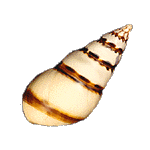

The Ecology of Liguus

The Liguus tree snails have a yearly life cycle which is closely coupled to climatic conditions, specifically the sub tropical rainy and dry seasons. The yearly life cycle of the Liguus begins in the spring with the first warm rains. Eggs hatch and adult snails wake up from their aestivation (hibernation). The snails grow, mate and lay eggs from spring thru fall, mid to end of May through November. Aestivation usually begins around the first cool weather in October or November. These events are can be triggered or stopped by localized weather conditions. Flooding and long dry periods can affect the Liguus populations by dessication or death of the eggs by prolonged flooded conditions. Prolonged below freezing cold spells can also affect Liguus populations.
Liguus is a hermaphroditic gastropod, that is, it is both female and male. Genetic research has established Liguus fasciatus as partially self fertilizing, however this does not obviate the need for copulation by two individual snails. Mating occurs during July and August with egg laying following during the heavy rains of September. The Liguus hollows out a shallow tunnel / chamber in the humus soil near the host tree and lays up to two dozen whitish pea size eggs. The eggs hatch during the first warm rains of the spring and the small perfectly formed Liguus crawl toward the nearest tree.
Liguus have an oblong conical shell which grows in a dextral direction about the central axis. Very rare individuals have been found to be sinistral, that is, growing in a left handed direction about the central axis. The Liguus have a natural life span of six to seven years and exhibit clearly marked lateral varices or growth marks indicating the yearly arrest in growth which occurs during aestivation. A typical Liguus population structure within an undisturbed hammock is comprised of definite age classes; 25% - 2 yrs, 40% - 3 yrs, 20% - 4 yrs, 8% - 5 yrs and 5% - 6 yrs. This profile is from a specific hammock and can vary due to drought and other climatic factors such as severe cold spells.
The Florida Liguus undergo a period of dormancy or aestivation starting in November or December and which lasts through May or April of the next year. Upon sensing dry conditions, shorter days and lower temperatures, the Liguus finds a protected location and secretes a mucus seal or epiphragm. This seal protects the snail from dehydration during the winter period of lessened humidity and rain. The Liguus breaks out of aestivation during the beginning of the rainy season in April or May. This breakout does not occur simultaneously throughout the South Florida area. Liguus may be active in the Keys or Long Pine Key area but still aestivating in the Pinecrest area, which is farther north. The Liguus of Cuba, Isle of Pines and Hispaniola follow a similar pattern of aestivation keyed to the local dry season (which is very close to the Winter months of South Florida).
The Liguus Tree Snails feed on the confervoid algae, fungi, sooty molds and lichens which grow on subtropical hardwood trees and shrubs . Liguus do not eat the leaves or bark of the host tree. Feeding paths may be seen where the snail has scraped the algae and lichen growths with their radula. The quality of the hammock, that is, the amount of food and type of food, affects the shell growth of the Liguus. Poor quality hammocks cause the shell to be rather thin and the total length of the shell to be shorter.
Liguus inhabit the subtropical hardwood hammocks (tree islands) growing on the rocky limestone outcroppings of the Everglades, Atlantic Coastal Ridge and the Florida Keys. In Cuba and Hispaniola the Liguus live in similar tropical hardwood forests in both mountainous and coastal terrains. In Cuba there are isolated, forested, limestone outcroppings, known as "Mogotes" in the Pinar Del Rio province (Western end of the island). Each Mogote has an endemic color form of Liguus just as in the isolated hammocks of the Everglades. The Liguus displays a marked preference for certain tree species. The preferred or host tree on the mainland of Florida and North Key Largo is; Wild Tamarind (Lysiloma latilisiqum ). Other host trees are Poisonwood (Metopium toxifera ), Gumbo Limbo (Bursera simarouba ), Mastic (Mastichodendrum foetidissimum ) and other smooth barked hardwoods. Host trees of the Liguus in the Middle and Lower Florida Keys are; Jamaica Dogwood (Piscidia piscipula ), Poisonwood ( Metopium toxifera ), Pigeon plum (Coccoloba diversifolia ), Ironwood ( Krugiodendron ferreum ) and other hardwoods native to the Florida Keys hammocks.
Liguus are preyed upon by a variety of vertebrates and invertebrates; oppossum, racoon, birds, rats, the carnivorous snail Euglandina rosea and the most destructive enemies of all; bulldozers and aerial spraying of insecticides. Habitat destruction is by far the greatest threat to the Liguus. The most common natural predation is by the carnivorous snail Euglandina rosea . This snail attacks the Liguus on the ground as it lays eggs or travels from tree to tree. The Euglandina is a ground dwelling species but it has been observed, in few instances, to climb trees in search of the Liguus . The danger from fire ants, proposed by some environmental authorities, seems to be minimal as there appears to be a secretion by the Liguus which repels ants to some degree. The real estate development of hammock areas is by far the greatest threat to the Liguus of South Florida and the Keys.